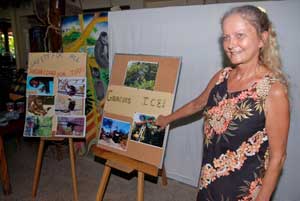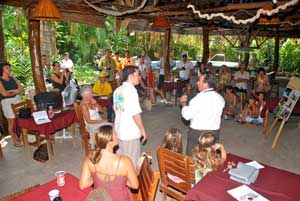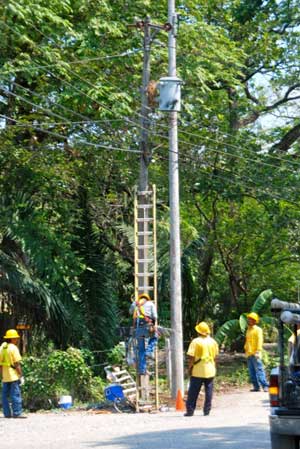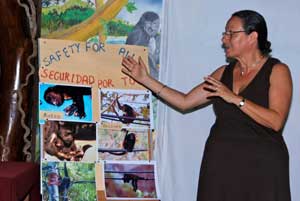
Brenda Bombard has worked closely with ICE on collecting data that enabled the electric company to move forward with insulating electric lines. Photo credit: Christopher Lee
|
|
It’s ten in the morning and the jungle heat is already thick in the open-air restaurant and among the gathering crowd. The few diners have been pushed to the back and the main space is the stage for an Earth Day news conference billed as a ‘critical meeting’. Posters with pictures of maimed and electrocuted monkeys are displayed next to a large white tablecloth that hangs from a partition and serves as a projection screen. A supportive Costa Rican and gringo “monkey friendly” audience, mopping their brows and drinking ice water and orange juice, listen attentively as ICE electric company representatives click through slides and explain their tactics to save the country’s howler monkeys whose numbers have been decimated, mostly through power line electrocutions.
In 2009, Brenda Bombard counted 132 monkey deaths in the Nosara area alone. But Bombard, who runs the area’s only refuge (www.nosarawildlife.com), which takes in maimed and injured monkeys jolted by bare, high-powered electrical wires, stresses that the death-count covers just those that have been reported and verified. |
| |
|

The Earth Day news conference attracted a mix of Costa Ricans and gringos concerned over the plunging numbers of howler monkeys. Photo credit: Christopher Lee |
|
Countless other monkeys, she laments, are fatally injured and die unnoticed. She believes her numbers are merely a hint of the actual toll, and at that, only in this small region of the Central Pacific coast in Guanacaste province. As development soars and homebuilders look for the quickest way to cut costs, arboreal wildlife takes the hit with the monkeys being the most visible and frequent victims. Nationally, it’s estimated that their populations have been gutted by more than half since 1995 - due mostly to horrible electrocutions from un-insulated, above ground live wires.
Bombard, along with, Vicki Coan, who runs the SIBU sanctuary that returns rehabilitated monkeys to the wild, have been activists around this issue for more than 10 years. But Bombard says it’s only since they started their detailed death counts two-and-a-half years ago (143 deaths in 2008) that the electric company took serious notice of the destruction of one of its most precious natural assets.

ICE is insulating 20 kilometers of electric wire in the Nosara and Guiones area to protect the monkeys. Photo credit: Christopher Lee. |
|
“I think that they’re just coming around to the fact that this is a huge issue. As we’ve been documenting the number of monkeys being killed they [the government] are now comprehending the severity of it.”
It appears that it’s the hard data that Bombard and Coan’s organization has collected that’s garnered the attention of the government agency that installs the country’s electric lines. As reported in the April issue of VON, ICE announced last month that the utility is using the Nosara area as a pilot program to insulate 20 kilometers (about 66,000 linear feet) of electric wires at the cost of US$400,000.
So Bombard and Coan organized this event on April 22nd – Earth Day – more as a vote of confidence for ICE and to honor the link between the monkeys’ survival and ICE’s act of environmental stewardship. Importantly, since the first wires were insulated in mid-February 2010, only three monkey deaths have been counted. A far cry from the 22 that Bombard reported between January 1 and February 12, which is a death about every other day.
|
Everyday Earth Day
While ICE has committed to continuing their line insulation work into 2011 and 2012, they also invited current and future homeowners and property developers to take a proactive role in saving the monkeys. There are two primary approaches for property owners.
First is making the power lines on private land safe. Bombard gives a run-down of approaches from the best to adequate:
• The very best is burying wires underground with transformers installed on the ground with cages over them. It’s totally animal-proof.
• The next best is to insulate just one of your wires—the top wire is preferred as monkeys grab the highest object to move from one place to another. You also need to cover each of your transformers with a rubber boot. Both the insulation and the boots are now available in Costa Rica through ICE. Insulated wire is about $1 per foot more than the un-insulated wire. But note that you only have to cover one wire not both. The boot set for a transformer is around $125 but hefty taxes and shipping can make that closer to $200.
• If you simply can’t swing the costs then Bombard says you can ask ICE to spread the two wires going across your property by two meters, a length that monkeys can’t span. But this means you have an on-going responsibility to keep the trees and vines cut back because if a tree grows into the two wires and touches both of them, the entire tree becomes electrified.
• “If you can’t do that,” she sighs, “then I suggest you put your project on hold until you can come up with the funds to do it. Because why are we all moving here? We’re moving here for this environment and the animals are a very important part of it.”
Besides saving the lives of the monkeys, there are two important side benefits to insulating your lines according to ICE. For one, insulation allows for better electrical conductivity so you get more energy efficient electricity, which can save you (and ICE) money on electric bills. Additionally, the insulation protects the lines from trees and debris brushing up against them and shorting-out so you end up having fewer power outages.
The cost varies with the size of the property or project. For example, Tom Peifer, the developer of Pueblo Verde (www.puebloverde.org), an eco-community project north of Nosara. Peifer decided to pay the extra cost for line insulation, which is about US$10,000 for 14 lots. It was a difficult decision for him as his budget is squeezed and the move required an immediate halt to the planned electrical system installation. “It‘s clear that we are running a minimal risk of electrocution but it was enough of a risk that we felt we had to take all measures possible with installation and subsequent planting.”
Monkey Friendly Trees
Once electric lines are insulated or buried, it’s important to plant ‘monkey’ friendly trees, according to Anny Chaves, a biologist working with ICE on environmental issues. These will attract and keep the monkeys fed during the hottest and driest months of the year (once the rainy season sets in, food is in abundance).

ICE's Biologist Anny Chaves explains how planting the right trees is important to saving the monkeys. Photo credit: Christopher Lee |
|
Trees such as mango, pochote, papaya and some 40 other types produce food during the driest months. These trees bloom when others are in hibernation. Some, like the pochote (which sprouts little green and red fruits) regenerate easily and can grow simply from a branch stuck in the ground.
There are some 40 varieties of trees that you can plant on your property that monkeys will use for food during the dry season. If the monkeys have food within close proximity they will be less likely to venture out and this will limit their exposure to more power lines.
|
For a pdf list of trees that attract monkeys, click here.
|

